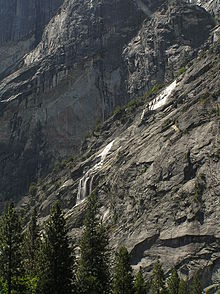Ephemerality


Ephemerality (from the Greek word ἐφήμερος, meaning 'lasting only one day'[2]) is the concept of things being transitory, existing only briefly. Academically, the term ephemeral constitutionally describes a diverse assortment of things and experiences, from digital media to types of streams.[3] "There is no single definition of ephemerality".[4] With respect to unique performances, for example, it has been noted that "[e]phemerality is a quality caused by the ebb and flow of the crowd's concentration on the performance and a reflection of the nostalgic character of specific performances".[5] Because different people may value the passage of time differently, ephemerality may be a relative, perceptual concept: "In brief, what is short-lived may not be the object itself, but the attention we afford it".[6][7]
Ephemerality and nature
Geographical features
An ephemeral


Small wetlands are often ephemeral and ephemeral ecosystems are often aquatic;
Ephemeral habitat patches have repeatedly been assessed as detrimental to metapopulation persistence, although metapopulations aren't always negatively affected by ephemeral landscapes.[25] These patches occur as a result of the habitat's turnover.[26] Ephemeral streams have, relative to their perennial counterparts, lower species richness; the streams are "potentially demanding" for inhabitants, although some species do reside.[27]
Ephemeral rivers sometimes form
The ephemerality of a river network is a particularly significant element in the
Examples of ephemeral streams are the
Any
There are also ephemeral islands such as Banua Wuhu and Home Reef. These islands appear when volcanic activity increases their height above sea level, but disappear over several years due to wave erosion. Bassas da India, on the other hand, is a near-sea level island that appears only at low tide.[citation needed] On account of changing demarcation, shores exist as ephemeral.[34]
Only a small amount of southern
Biological processes
Plants whose life cycle is significantly less than the time of a
Animals can be ephemeral, with
.Ephemerality is a component of olfaction, breathing, speech and memory, aligned with permanency in the latter.[39][40][41][42] With regards to witnessing an artwork in a museum, limited research indicates that the ephemerality of solely gazing at the artwork results in greater remembrance compared to the resulting memory from taking a photograph.[43] Psychologists have studied why ephemerality may improve memory retention; social psychologist Karl E. Scheibe, conversely, suggested that ephemeral images are only memorable if repeated.[44][45] The ephemerality of memory leads objects to assume the function of begeting remembrance on account of their greater stability.[46]
Ephemerality and society
Ephemeral objects
Objects which are ephemeral, per one perspective, are those whose compositional material experience chemical or physical changes and are thus permanently altered; this process occurs in a matter of decades.
Baudelaire, who considered aesthetics to be centered around an interplay of the perennial and the ephemeral, defined the artistic component of modernity by its ephemeral quality.[73][74] Sarah Kofman posited that art is utilised to abate the "intolerable nature of all ephemeral things".[75] Ephemerality has been relevant to a considerable amount of art; various artists have drawn upon the matter to explore time, memory, politics, emotions, spirituality and death.[53][76] The Dada, Fluxus, Surreal, and Futurist movements all incorporated ephemerality as have Kuba, Mono-ha, and ukiyo-e.[77][78][79][80][53][81] Perceptions of ephemerality vary between cultures, from melancholy and mitigation to embrace.[57][82][a] Performance art has frequently been described as ephemeral in nature; with regards to historical performances, the traces: playbills, scrapbooks of newspaper clippings and material artifacts are themselves ephemeral.[85][86]
Literature is ephemeral, including definitions and "all printed texts".[87][88][60][89] Ephemeral was first used colloquially in reference to printed matters.[90] By 1750, an "expansion of all kinds of ephemeral print" had occurred.[91] Hazlitt contended that such ephemerality was the result of widespread aestheticism, thus the creations were subject to being abruptly disregarded due to the cascading "gaze of fashion".[60] Wallace Stevens adjusted his poetic standards due to a "perception of ephemerality" that living in New York City instigated.[92] Art Spiegelman asserted that the format of comics, even during degradation, defies ephemerality, although they have been deemed as such.[93] Women's writing, the likes of diaries and political pamphlets, have amassed a status as long being ephemeral, acknowledged by some affected in the then-present.[94][95] The ubiquity of digital media has spurred the opinion that print material is comparatively less ephemeral.[96] Elisa New and Anna Akhmatova varyingly opined that poetry is a means of repealing mortal ephemerality, with Akhamatova invoking the aphorism ars longa, vita brevis ("skillfulness takes time and life is short").[97][98]
Ephemeral objects chiefly disappear; when preserved it is often knowingly, having been "rescued from ephemerality", though this practice is still fraught with uncertainty and an object's ephemerality may only be suspended, thus still capable of being transitory.[99][62][100] The legacy of ephemerality often manifests as "traces, glimmers, residues, and specks of things".[101] Literature may contest, document or approximate ephemerality although the immateral nature means that there can only be an approximation: "In other words, there must always be an ephemeral beyond the ephemeral".[102][87][103][104] Film has been used to document and combat ephemeral aspects of human development.[105] Digital media's encompassing archival process means that information of varying importance can either be affixed or ephemeral, the former seen as the more generally common outcome.[106][107] Digital personas, on account of precariousness and whim, can be entirely ephemeral, without any record.[106][108] Grey literature has prove particularly vulnerable to the internet's ephemerality.[109]

Ephemeral acquired its common meaning of short-living in the mid-19th century and has connotations of passing time, fragility, change, disappearance, transformation, and the "philosophically ultimate vision of our own existence".[111][112][113][b] Sarah Kofman questioned if "the beauty that conceals the evanescent nature of all things were itself ephemeral".[75] Rather than melancholic, Sigmund Freud and Walter Pater viewed ephemerality as valuable; awareness and acceptance were to Freud commendable.[115][116]
Ephemerality as a human condition
Multiple scholars have viewed ephemerality as intrinsic to the human condition, a phenomenon of physicality.[6][117][118][119][120] A significant amount of living is ephemeral, considered by some as a component of everyday life: "we might best understand the ephemeral as a routine and constant force... that establishes the presence of the everyday".[7][121][66][122] Ephemeral aspects are evident in communication, of both digitial and physical origin.[123][124] In the digital realm, online interactions straddle permanency and ephemerality, new posts proliferate such that participants adopt a social norm that "the discourse will pass and be forgotten as the past".[123] Ephemerality is a technologically and socially reliant concept – relative and historically changing.[96] The rudimentary technology of early radio led to the media broadcast being ephemeral and for a substantial amount of time spoken communication was ephemeral.[125][126][c] Written communication, historically and presently, has been influenced by ephemerality.[128] The emergence of new digital media and technology develops what we deem ephemeral, to the point that ephemerality is perhaps an "outdated concept".[96][129]

Within the context of modern media dissemination, YouTube videos, viral emails and photos have been identified as ephemeral; as have means of advertising, both physical and digital and the internet collectively.[130][131][132][d] Ephemeral media has been described as that which is brief in duration and/or circulation, adjacent to "the primary texts of contemporary entertainment culture".[134] YouTube has "become a hugely successful aggregator of ephemeral media".[133] In 2009, Ian Christie considered that a substantial amount of modern media, aligned with "rapid proliferati[on]", "may prove much more ephemeral than the flip-book".[135]
Ephemerality has received increased attention from modern academics, in fields such as:
Like a blade of grass,
My frail body
Treading the path to Kyoto
Seeming to wander
Amid the cloudy mist on Kinobe Pass.
Ephemerality has been studied in the context of dancing.[155] Witnessing a dance that will be rendered ephemeral is resultingly commodified and of greater desire to prospecting audiences; the same is true of fairs.[156][157][f] Muñoz posited that the physical proximation of dance, which coupled with the "shared rhythm", results in a unified yet ephemeral status of those engaged.[158] La Sylphide sees ephemerality as a notable theme.[84] Professor of Dance Mark Franko contended that the artform is approaching a state of being "post-ephemeral" while Diane Taylor viewed the lasting impact a performance may have as negating notions of ephemerality.[148][159] The documentation of other ephemeral events: protests, installations, exhibitions, are often meager – public events, of varying size, naturally generate ephemeral material.[160][161][g]
"[Ephemerality] and disposability" have been perceived as components "of an American ethos";

Karl Marx and Friedrich Engels' perception of ephemerality "represents a thoroughly modern experience".[168] Ephemerality was furthermore prominent in the late 20th century, on account of multiple social features; Reiko Tomii described ephemerality as a "defining issue of the 1960s".[169][170] In the 21st century, ephemerality "continues to signify concerns about the overflow of information, its evanescence, and questions of what or should be preserved".[128] David Harvey defined postmodernism as "a total acceptance of ephemerality".[171]
Architecture of an ephemeral nature appears as increasingly commonplace, on account of global and capricious hyper-mobility and mass displacement.[172] Marc Augé observed ephemerality as key to the likes of airports, malls, supermarkets, office blocks, and hotels thus rendering them, per his definition, "non-places".[173] Architecture scholar Anastasia Karandinou argued that the practice's modern relation to ephemerality correlated with digital media's evolution, which she says has enabled new conceptions of space and everyday thinking.[174] Of an indefinite and contentious nature, the definition of a region is ephemeral.[175]
See also
References
- ^ Literature scholar Peter Schwenger further stated that "the traditional lament of the ephemeral object" is one of sadness at witnessing beauty fade away.[83] Professor of English Andrea Henderson wrote that said lament occurs as a result of "attaching oneself to ephemeral objects", which are "made lovely" due to their short-lived nature.[84] John Keats defined melancholy as profound desire resulting from ephemeral objects.[84]
- ^ Ephemeral in early archival theorisation often indicated little value.[114]
- ^ Lance Sieveking's oeuvre provides a common example of early radio's ephemerality and the resulting effect; his extensive work was eventually rendered lost.[127]
- ^ YouTube videos, according to film scholar Paul Grainge, are ephemeral due to "the brevity of its clips".[133]
- ^ At least half of the San Diego Museum of Contemporary Art's collection was deemed by curator Elizabeth Armstrong to be "some degree ephemeral".[149]
- ^ Discussing ephemerality in relation to artworks, Purpura posited that it defies the commodification of art.[53]
- ^ Archivist Katrina Windon described the process of documenting the ephemeral as dialetical.[149]
- S2CID 129716791.
- ^ Ephemeros, Henry George Liddell, Robert Scott, "A Greek-English Lexicon", at Perseus
- S2CID 247969223.
- OCLC 1158015759.
- ^ Will Straw, Alexandra Boutros, Circulation and the City: Essays on Urban Culture (2010), p. 148.
- ^ a b Ronald Beiner, Political Philosophy: What It Is and Why It Matters (2014), p. 10.
- ^ S2CID 219960862.
- ^ S2CID 83612253.
- ISSN 0169-555X.
- S2CID 228921477.
- ^ S2CID 247332775.
- ^ PMID 27861768.
- S2CID 85331539.
- ISSN 0006-3568.
- ^ PMID 34603854.
- ^ S2CID 154713741.
- S2CID 219744576.
- S2CID 87000604.
- ^ PMID 35247072.
- ISSN 0046-5070.
- S2CID 213241715.
- ISSN 0066-4162.
- S2CID 44759441.
- S2CID 3242106.
- S2CID 15472069.
- JSTOR 24876158.
- S2CID 91835792.
- ISSN 0140-1963.
- ^ "The Wondrous Waterholes of Northern Australia". Australian River Restoration Centre. 4 December 2015. Retrieved 9 February 2024.
- ISSN 0309-1708.
- PMID 35673327.
- ^ "Death Valley Alive With Wildflowers", MSNBC (March 14, 2005).
- S2CID 129599417.
- S2CID 134824825.
- S2CID 91258573.
- ^ ISSN 0142-6397.
- ^ OCLC 1100041140.
- ^ OCLC 619552330.
- ISBN 978-0-19-872230-4.
- S2CID 162327675.
- ^ Fuller, Saunders & Macnaughton 2021, p. 486.
- S2CID 8047589.
- S2CID 202782412.
- S2CID 239629237.
- ^ JSTOR 42978851.
- JSTOR 24739829.
- S2CID 57570843.
- ^ The Multigraph Collective 2018, p. 127.
- ^ The Multigraph Collective 2018, p. 126.
- ISBN 978-0-19-539804-5.
- ^ Wasserman 2020, p. 110.
- ^ Wasserman 2020, p. 6.
- ^ S2CID 57568572.
- ^ S2CID 145724698.
- ^ Russell, Gillian (2014). "The neglected history of the history of printed ephemera". Melbourne Historical Journal. 42 (1): 7–37.
- OCLC 813232892.
- ^ a b Quinz, Emanuele (2014). "For an Esthetics of the Ephemeral". Hybrid. 1: 49–59.
- ISBN 978-0-19-878337-4.
- ISBN 978-0-19-873233-4.
- ^ a b c Stewart, David (2013). "Hazlitt, The Living Poets, and Ephemerality" (PDF). The Hazlitt Review. 6 (1): 47–59.
- S2CID 149123338.
- ^ a b Wasserman 2020, p. 2.
- S2CID 237865158.
- ^ ISBN 978-1-350-07229-9.
- OCLC 847131730.
- ^ a b The Multigraph Collective 2018, p. 130.
- ^ Fuller, Saunders & Macnaughton 2021, p. 17.
- ^ Zieger 2018, p. 11.
- S2CID 213899584.
- ISBN 9781350074774.
- ^ Eeckhout & Goldfarb 2012, p. 112, 118.
- OCLC 423389300.
- OCLC 949884201.
- S2CID 193194312.
- ^ ISSN 2155-1162.
- OCLC 952728867.
- ISBN 9781606061343.
- S2CID 170322468.
- S2CID 246283112.
- ^ Liu-Brennan, Damien; Bryce, Mio (2010). "Japanese Fireworks (Hanabi): The Ephemeral Nature and Symbolism". International Journal of the Arts in Society. 4 (5): 189–201.
- JSTOR 25781215.
- ^ Campoli, Alessandra (2010). "Tropical Melancholy: The Ephemeral in Thai Visual Imagination". 4th Annual International ACSA Conference, the Visual Imagination: Across Boundaries: 14.
- ^ Wasserman 2020, p. 30.
- ^ S2CID 143018535.
- OCLC 526106420.
- S2CID 162841068.
- ^ S2CID 193272024.
- S2CID 192946334.
- ISBN 978-0-19-923219-2.
- ^ Russell 2020, p. 56.
- ^ Russell 2020, p. 33, 44.
- ^ Eeckhout & Goldfarb 2012, p. 105.
- S2CID 144410203.
- S2CID 166046765.
- ^ Wasserman 2020, p. 33, 183.
- ^ ISBN 9781501338519. Retrieved 2021-12-19.
- ISBN 9780804765688.
- ISBN 978-0-7486-6575-4.
- ^ S2CID 64210339.
- OCLC 1245956071.
- S2CID 150849886.
- ^ S2CID 214613899.
- S2CID 158590919.
- S2CID 134360215.
- ^ Anselmo-Sequeira, Diana (2013). "Apparitional Girlhood: Material Ephemerality and the Historiography of Female Adolescence in Early American Film" (PDF). Spectator. 33 (1): 25–35.
- ^ S2CID 145568162.
- ^ S2CID 228863154.
- S2CID 145208972.
- ^ Witt, Steven W.; Rudasill, Lynne M. (2015). "World Sustainable Development Web Archive: Preserving and disseminating knowledge for sustainable growth". Archived from the original on 1 June 2022.
Paper presented at: IFLA WLIC 2015 - Cape Town, South Africa in Session 90 - Preservation and Conservation with Information Technology.
- ISBN 978-3-11-042766-0.
- S2CID 60723329.
- JSTOR 40858619.
- ISBN 978-0-7190-8857-5.
- S2CID 194031057.
- ^ ISSN 0015-8518.
- S2CID 161169531.
- ISBN 9780520204676.
The ephemeral encompasses all forms of behavior – everyday activities, story-telling, ritual, dance, speech, performance of all kinds.
- S2CID 191318485.
- .
- S2CID 235448233.
- ^ Russell 2020, p. 31, 33, 40.
- S2CID 190490100.
- ^ S2CID 158239655.
- PMID 30294721.
- JSTOR 26920256.
- ^ Oard, Douglas W. (2004). "Transforming access to the spoken word" (PDF). Proc. International Symposium on Large-scale Knowledge Resources: 57–59.
- ^ S2CID 143792011.
- ^ a b Russell 2020, p. 254.
- ^ Wasserman 2020, p. 67.
- ISSN 0021-8529.
- S2CID 241718872.
- S2CID 58248647.
- ^ a b Grainge 2011, p. 8.
- ^ Grainge 2011, p. 10.
- ISSN 1744-1854.
- S2CID 158671551.
- S2CID 145282629.
- JSTOR 90011876.
- S2CID 192901932.
- S2CID 219020431.
- ^ Wasserman 2020, p. 24.
- ^ Eeckhout & Goldfarb 2012, p. 117.
- ^ Heine 2020, p. 170.
- ISSN 2045-290X.
- OCLC 1111954968.
- ^ Heine 2020, p. 121, 143, 144.
- OCLC 502389441.
- ^ S2CID 246612552.
- ^ S2CID 191614867.
- ^ Russell 2020, p. 33.
- S2CID 194082843.
- S2CID 109010637.
- S2CID 111270449.
- ^ Heine 2020, p. 144.
- S2CID 216399732.
- ISBN 978-0-19-977261-2.
- ^ Wasserman 2020, p. 45.
- S2CID 161746319.
- ISBN 978-0-521-87401-4.
- OCLC 50253087.
- ISBN 978-0-642-27601-8.
- ^ Wasserman 2020, p. 23.
- ^ Wasserman 2020, p. 74, 77.
- JSTOR 26571402.
- OCLC 1139770505.
- ISSN 0740-770X.
- ^ Klinger, Max (1889). "On Death, Part I". Cleveland Museum of Art. Retrieved 12 November 2021.
- S2CID 162633405.
- JSTOR 42801108.
- ^ Wasserman 2020, p. 27.
- ISBN 9780803988132.
- ISBN 978-90-485-3582-8.
- OCLC 980874927.
- OCLC 975872838.
- S2CID 145050355.
- Eeckhout, Bart; Goldfarb, Lisa, eds. (2012). Wallace Stevens, New York, and Modernism. Taylor & Francis. ISBN 9781136330452.
- Grainge, Paul, ed. (2011). Ephemeral Media: Transitory Screen Culture from Television to YouTube. OCLC 713185432.
- Heine, Steve (2020). Readings of Dōgen's "Treasury of the True Dharma Eye". Columbia University Press. ISBN 9780231544085.
- Russell, Gillian (2020). The Ephemeral Eighteenth Century: Print, Sociability, and the Cultures of Collecting. Cambridge Studies in Romanticism. Cambridge University Press. ISBN 978-1-108-48758-0.
- Fuller, David; Saunders, Corinne; Macnaughton, Jane, eds. (2021). The Life of Breath in Literature, Culture and Medicine. Palgrave Studies in Literature, Science and Medicine. S2CID 244605694.
- The Multigraph Collective (2018). Interacting with Print: Elements of Reading in the Era of Print Saturation. University of Chicago Press. ISBN 9780226469287.
- Wasserman, Sarah (2020). The Death of Things: Ephemera and the American Novel. Minneapolis: University of Minnesota Press. ISBN 978-1-4529-6414-0.
- Zieger, Susan (2018). The Mediated Mind: Affect, Ephemera, and Consumerism in the Nineteenth Century. Fordham University Press. ISBN 978-0-8232-7985-2.
Further reading
- ISBN 2-7186-0622-3


